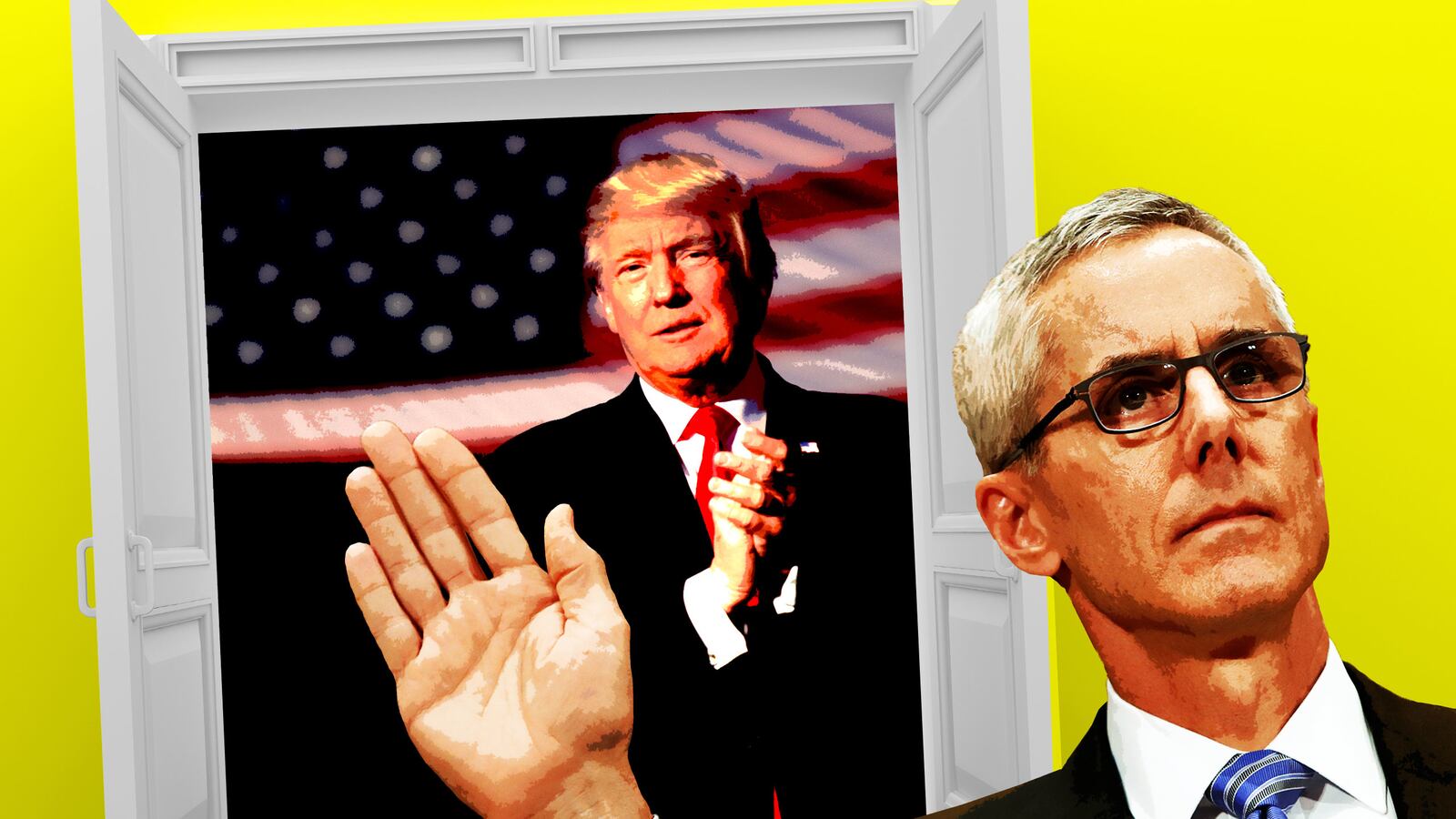TSA administrator Peter Neffenger spent Thursday saying his goodbyes after only a year and a half at the post, a casualty of the disarray in some parts of the Trump transition process. Team Trump called him only in the last two weeks to ask him to stay—too late to change his plans, U.S. officials tell The Daily Beast.
Widely hailed as competent and innovative by Congress, Neffenger is a retired admiral and a political independent. He’s also the fifth chief of the Transportation Security Administration in as many years. Congressional sources disappointed over his departure say they may draft legislation to set terms for the TSA role, akin to the 10-year term for the FBI director.
The missed opportunity to keep Neffenger at his post reflects the late start the Trump transition team got when it dropped New Jersey Gov. Chris Christie as its transition lead just after the election—and also reflects the sharp-elbowed jockeying among Trump advisers and campaign staff as they scramble to fill the thousands of soon-to-be empty posts after an election they didn’t expect to win. Outgoing Obama administration officials fear the staffing melee will leave the new administration unprepared to cope with a crisis, but Trump transition officials—and Democrats who’ve gone through transitions before—say it’s par for the course, and that Washington, D.C.’s standing bureaucracy will keep government running until the top posts are filled.
Neffenger sat down for an exclusive interview earlier in the week, before The Daily Beast learned he’d been asked to stay. He outlined an ambitious program of how he’d tried to turn around an agency riven with bad morale and poor performance. But the programs he set in motion—from retraining TSA agents to better spot suspicious objects, to streamlining how to speed new technology into use to screen passengers—are less than a year old, and GOP enthusiasm for what he’s done apparently reached Trump Tower too late.
“The administrator deeply appreciates the support he has been receiving, but his current plan is to depart with the outgoing administration,” Neffenger’s spokesman Richard Ades emailed Thursday, refusing to confirm that Trump aides had requested Neffenger stay, to provide continuity like a handful of other senior Obama administration officials related to national security.
For instance, the State Department coordinator of the campaign to fight the so-called Islamic State, Brett McGurk, will be staying for a few more months to help the new team, as will Undersecretary of State for Political Affairs Tom Shannon, as State Department spokesman John Kirby confirmed to reporters Thursday. Incoming White House spokesman Sean Spicer told reporters Thursday that others who will stay on include Adam Szubin as acting undersecretary for Treasury for terrorism and financial intelligence.
Trump spokesmen did not immediately respond to requests for comment about Neffenger.
When Neffenger arrived in 2015, the TSA was reeling from an Inspector General report that found multiple lapses. Agents had failed 67 of 70 security tests, including failing to spot undercover investigators who got through checkpoints items that were potential weapons.
The former Vice Commandant of the U.S. Coast Guard, Neffenger was incident commander of the Deepwater Horizon oil spill. He still feels the aches and pains of fast-roping onto moving ships in his younger years, when he was part of a synchronized team that took pride in its work. That history is why one of the first things he targeted to fix was the esprit de corps among the demoralized work force tasked with screening roughly 2 million passengers a day.
He made them all re-take an oath of office, and rebrand themselves—and the TSA—as what he called “an intelligence-driven, adaptable counterterrorism agency,” rather than the people who make Americans’ attempts to travel from A to B miserable.
He also convinced Congress to stop bleeding off TSA’s budget to pay for other things, stopped the shrinkage of the ranks of agents, and allowed anyone who was part-time to apply for full-time jobs.
Of the infamous long lines under his tenure, he said that was all about not having enough staff.
“We didn’t have enough people to man the checkpoints. We could staff about 60 percent of the peak at the top 30 airports,” he said.
He said thanks to Congressional funding, TSA is now fully staffed at those peak hours, and thanks to outreach to airlines, TSA now tracks when planes are arriving or departing from heavily trafficked airports and tries to staff for surges of passengers accordingly.
“We look at the top 30 airports, checkpoint by checkpoint hour by hour,” he said. “You still get long waits but they don’t last all day long.”
He also made everyone, from managers to front-line agents, learn how to do the one thing at TSA that everyone hates.
“I made everyone in the agency learn how to do a pat-down. That just comes from my military background,” he said. “There’s not a thing you ask your people to do that you haven’t done by the time you’re in command.” Not everyone liked it, but he said it helped managers understand what they were asking of their people, and why it takes a toll on agents as well as passengers.
He said there were management practices that had to be changed—the inspector general report had found many personnel complaints of unfair treatment, so he set up a system to track the complaints and let whistleblowers know what was being done.
“You can’t fix everybody overnight,” he said. “You can convince them there’s a process that’s going to take care of them and treat them fairly.
He also established a TSA Academy to try to institutionalize lessons learned across the force, and instituted a rolling stand-down of agents to retrain them in how to use the scanners to spot suspicious objects in luggage or on people.
“We put a lot of pressure on the workforce to move people through, but we hadn’t trained them on the effectiveness of the equipment,” Neffenger said.
He said it was too soon to tell if those changes made the agents more effective.
A U.S. official briefed on recent covert testing said the training hasn’t yet produced a higher rate of spotting objects that are possible weapons, but the official said it would take a combination of better technology and higher skill levels among the agents—something Neffenger was working on. The official spoke on condition of anonymity to discuss the covert testing results.
The retired admiral said transportation remains a fixation for terrorist groups—both Al Qaeda of the Arabian Peninsula and the increasingly capable ISIS. He ticks off other recent transportation-focused violence, from the destruction of Metrojet Flight 9268 over northern Sinai in 2015, later claimed by ISIS, to last year’s attacks on the airports in Turkey and Brussels.
Neffenger was actually in Brussels the day the airport and metro were both attacked, and witnessed firsthand the destruction that killed more than 30 people.
While he’s heard of no credible threat aimed at Washington, D.C., on this Inauguration weekend, he said the new mode of rapid radicalization leading to action makes it hard-to-impossible to predict threats in advance.
“The activity level and dynamics are higher than they’ve ever been,” he said. “There’s a lot more threat reporting than we used to see. There’s just more players involved.”
That’s why TSA looks for patterns of travel rather than religion or ethnic background—a point of view that may have put Neffenger on the wrong side of the incoming administration.
“We look at where you are traveling to and from—are you coming out of places that are…generating bad things and connected to people affiliated with terror groups. That’s the kind of thing that’s going to get you on a watch list,” he said. “That’s independent and irrespective of your personal background.”
Neffenger says he wrote a TSA roadmap of “what did I do and how did I get there” to hand over to his successor, though since Team Trump hasn’t yet named one, that task will fall to his deputy, Huban Gowadia who will be acting administrator until a new one is named.
His parting advice is to think of an airport like a breathing entity of interlocking systems that have to speak to each other when they spot something odd rather than thinking of layers, one handing off to the next.
And there will always be risk.
“What constitutes a perimeter for the airport? Post Brussels attack, they had the barrier outside,” Neffenger said. “But there’s always outside the perimeter and you will always have a vulnerable crowd.”





